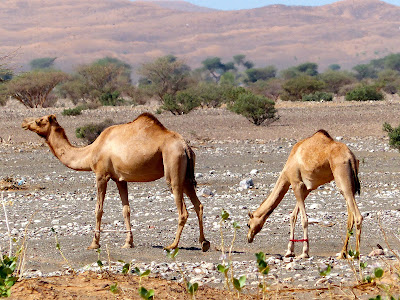We headed inland to the historic town of
Nizwa, our base for the next few days, making a brief incursion into
Wahiba (aka Sharqiya) Sands, a desert region covering 12,500 square kilometres.
 |
| Wahiba Sands |
The next day we headed into the
Al Hajar Mountains, which separate the low coastal plain of Oman from the high desert plateau and are home to
Jebel Shams, the highest mountain of the country at 3009m.
 |
| if you look closely you can see the old abandoned houses |
 |
| in the Hajar mountain range |
 |
| in the Hajar mountain range |
Jebel Shams has two summits: North (3009m) and South (2997m). The North Summit is occupied by a military base and is a restricted area.
 |
| Jebel Shams, Oman's highest mountain (3009m) |
Alongside Jebel Shams is Wadi Ghul, Oman's spectacularly deep answer to the Grand Canyon.
 |
| Wadi Ghul |
 |
| goat standing near the edge of Wadi Ghul |
 |
| goat in a tree |
On our way back we headed to Misfat, a picturesque mountain village.
 |
| Misfat |
 |
| traditional irrigation system ('aflaj') in Misfat |
 |
| in this photo you can see the old and new villages of Misfat |
Misfat is unusual in that the date trees are planted on terraces.
 |
| terraced date palms |
 |
| Misfat as the sun starts to set |
The next day we visited
Bahla Fort, one of four historic fortresses situated at the foot of the
Djebel Akhdar highlands in Oman.
 |
| Bahla Fort |
The Fort has been on the
UNESCO World Heritage list since 1987. The ruins of the fort are a remarkable example of this type of fortification, and attest to the power of the Banu Nebhan, the dominant tribe in the area from the 12th to the end of the 15th century.
 |
| Bahla Fort |
The walls and towers are made of unbaked brick and the foundations are of stone.
 |
| Bahla Fort |
 |
| Bahla Fort |
 |
| Bahla Fort |
 |
| Bahla Fort is also home to lots of bats |
We then headed to the plateau of
Jebel Akhdar, at 2000m above sea level.
 |
| Jebel Akhdar |
In the village of Al Ayn they grow roses and make rosewater.
 |
| Al Ayn |
In the village of Ar Rus, which only has 13 houses, we were very hospitably offered dates and qahwa (local coffee).
 |
| Ar Rus |
 |
| feral donkey (one of many in Oman) |
 |
| sunset at Jebel Akdar |
To return to the coast and
Muscat, we took the mountain road via Hatt and Wadi Bani Awf.
 |
| mountain road via Hatt and Wadi Bani Awf |
This is a spectacular if somewhat hair-raising drive and we were the only people driving our own car - all the other tourists we saw had drivers!
 |
| mountain road via Hatt and Wadi Bani Awf |
The mountain part of the drive is only about 70km long, but it can take several hours to drive, and a 4WD is essential.
 |
| mountain road via Hatt and Wadi Bani Awf |
 |
| Nakhal Fort |
You may also like:





































































